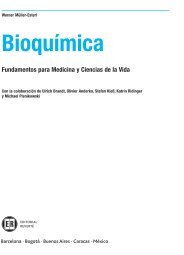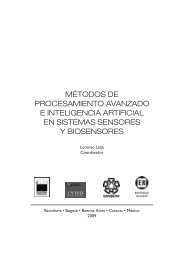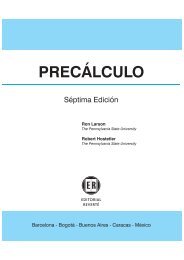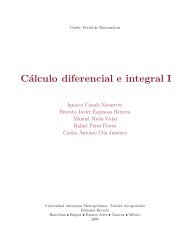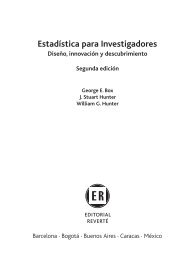Chapter 11 Gravity
Chapter 11 Gravity
Chapter 11 Gravity
You also want an ePaper? Increase the reach of your titles
YUMPU automatically turns print PDFs into web optimized ePapers that Google loves.
<strong>Gravity</strong><br />
16.7 d. Show that these data are consistent with an inverse square force law for<br />
gravity (Note: DO NOT use the value of G anywhere in Part (b)).<br />
Picture the Problem While we could apply Newton’s law of gravitation and<br />
second law of motion to solve this problem from first principles, we’ll use<br />
Kepler’s third law (derived from these laws) to find the mass of Jupiter in Part (a).<br />
In Part (b) we can compare the ratio of the centripetal accelerations of Europa and<br />
Callisto to show that these data are consistent with an inverse square law for<br />
gravity.<br />
(a) Assuming a circular orbit, apply<br />
Kepler’s third law to the motion of<br />
Europa to obtain:<br />
Substitute numerical values and evaluate MJ:<br />
2<br />
8<br />
π ( 6.71×<br />
10 m)<br />
−<strong>11</strong><br />
2 2 ⎛<br />
( 6.<br />
673×<br />
10 N ⋅ m /kg ) ⎜3.55d<br />
T<br />
2<br />
E<br />
2<br />
2<br />
4π<br />
3 4π<br />
= RE<br />
⇒ M J = R<br />
GM<br />
GT<br />
3<br />
4 27<br />
M J =<br />
= 1.<br />
90 × 10<br />
2<br />
24 h 3600s<br />
⎞<br />
× × ⎟<br />
⎝ d h ⎠<br />
Note that this result is in excellent agreement with the accepted value of<br />
1.902×10 27 kg.<br />
(b) Express the centripetal<br />
acceleration of both of the moons to<br />
obtain:<br />
Using this result, express the<br />
centripetal accelerations of Europa<br />
and Callisto:<br />
Divide the first of these equations by<br />
the second and simplify to obtain:<br />
Substitute for the periods of Callisto<br />
and Europa using Kepler’s third<br />
law to obtain:<br />
J<br />
2<br />
2<br />
E<br />
3<br />
E<br />
kg<br />
227<br />
⎛ 2πR<br />
⎞<br />
2 ⎜ ⎟ 2<br />
v T 4π<br />
R<br />
acentripetal<br />
= =<br />
⎝ ⎠<br />
= 2<br />
R R T<br />
where R and T are the radii and periods<br />
of their motion.<br />
a<br />
4π<br />
R<br />
4π<br />
R<br />
2<br />
2<br />
E = 2<br />
TE<br />
E and aC<br />
= C<br />
2<br />
TC<br />
a<br />
a<br />
a<br />
a<br />
E<br />
C<br />
E<br />
C<br />
4π<br />
R<br />
T<br />
=<br />
4π<br />
T<br />
CR<br />
=<br />
CR<br />
2<br />
E<br />
2<br />
E<br />
2<br />
RC<br />
2<br />
C<br />
3<br />
C<br />
3<br />
E<br />
R<br />
R<br />
E<br />
C<br />
T<br />
=<br />
T<br />
2<br />
C<br />
2<br />
E<br />
R<br />
=<br />
R<br />
2<br />
C<br />
2<br />
E<br />
R<br />
R<br />
E<br />
C



